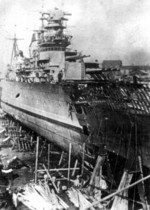Maxim Gorkiy
| Country | Russia |
| Ship Class | Kirov-class Light Cruiser |
| Builder | #189 Ordzhonikidze, Leningrad, Russia |
| Laid Down | 20 Dec 1936 |
| Launched | 30 Apr 1938 |
| Commissioned | 12 Dec 1940 |
| Decommissioned | 17 Feb 1956 |
| Displacement | 8,177 tons standard; 9,728 tons full |
| Length | 628 feet |
| Beam | 58 feet |
| Draft | 19 feet |
| Machinery | Six Yarrow-Normand boilers, TB-7 geared turbines, two shafts |
| Bunkerage | 650t oil normal, 1,660t oil full |
| Power Output | 122,500 shaft horsepower |
| Speed | 37 knots |
| Range | 4,880nm at 17.8 knots |
| Crew | 963 |
| Armament | 9x180mm/57 MK-3-180 guns, 6x100mm/56 B-34 DP guns, 9x45mm/46 21-K guns, 4x12.7mm DK machine guns, 6x533mm 53-38 torpedoes, 96 mines, 20 depth charges |
| Armor | 70mm belt, turrets, barbettes, bulkheads; 50mm deck; 150mm conning tower |
| Aircraft | two KOR-1 floatplanes |
| Sold for Scrap | 18 Apr 1958 |
Contributor: C. Peter Chen
ww2dbaseLike most of her sisters, light cruiser Maxim Gorkiy was named after a famous Russian politician. She was assigned to the Baltic Fleet in late 1940 and performed training duties until the German invasion of the Soviet Union. Upon the German invasion, she immediate departed to escort minelayers in the eastern Baltic, but hit a German minefield on 23 Jun 1941 and was forced to enter the drydock at Kronshtadt, Russia for repairs; both Maxim Gorkiy and destroyer Gnevny lost their bows from the explosions, with the latter lost. Between 3 and 21 Jul 1941, she had a new bow installed, and on 12 Aug she conducted new machinery trials. As the German troops neared Leningrad, she supported the defensive garrison by providing naval gunfire. On 4 Apr 1942, she was targeted by more than 70 bombs; two of them were near misses, and none hit. On 24 Apr, she was once again attacked, this time by 150 bombs and 50 artillery shells; near misses killed three and wounded five. On 25 and 27 Apr, near misses heavily damaged radios, rangefinders, boiler number 3, and a turbine. She was refitted during the winter of 1942-1943, receiving additional armor for her upper deck. In the spring and summer of 1943, she resumed her role as a naval gun platform. In Jan 1944, she supported the efforts to break the siege of Leningrad, firing 701 rounds from her primary guns during the combat. In Jun 1944, she supported Russian troops during the Vyborg-Petrozavodsk Offensive against the Finnish defenses of the Mannerheim Line. She remained in Leningrad until the end of the war. On 25 Feb 1946, she arrived at Liepaya, Latvia. In Dec 1950, she performed trials with the first Soviet shipboard helicopter Ka-10. In the summer of 1953, she was inactivated for a major refit, but by 1955 Russian naval leaders thought that she could not be modernized sufficiently. Modernization work was halted in 1955, and she was sold for scrap in 1959.
ww2dbaseSource: Warship 2009.
Last Major Revision: Dec 2009
Photographs
 |  |  |
Maxim Gorkiy Operational Timeline
| 12 Dec 1940 | Maxim Gorkiy was commissioned into service. |
| 17 Feb 1956 | Maxim Gorkiy was decommissioned from service. |
Did you enjoy this article or find this article helpful? If so, please consider supporting us on Patreon. Even $1 per month will go a long way! Thank you. Share this article with your friends: Stay updated with WW2DB: |
» Siege of Leningrad
Related Books:
» Warship 2009
- » 1,150 biographies
- » 337 events
- » 43,917 timeline entries
- » 1,241 ships
- » 350 aircraft models
- » 207 vehicle models
- » 375 weapon models
- » 123 historical documents
- » 260 facilities
- » 470 book reviews
- » 28,545 photos
- » 432 maps
Fleet Admiral Chester W. Nimitz, 16 Mar 1945
Please consider supporting us on Patreon. Even $1 a month will go a long way. Thank you!
Or, please support us by purchasing some WW2DB merchandise at TeeSpring, Thank you!